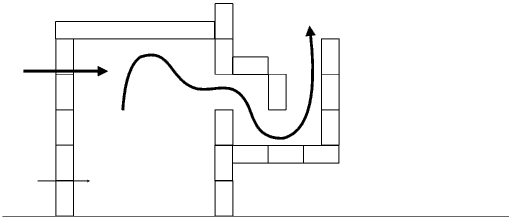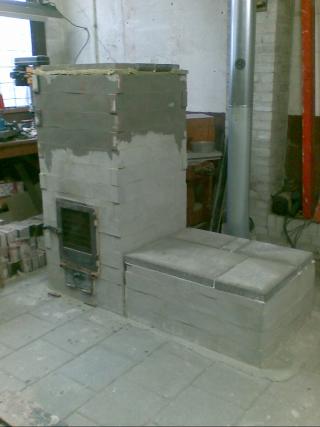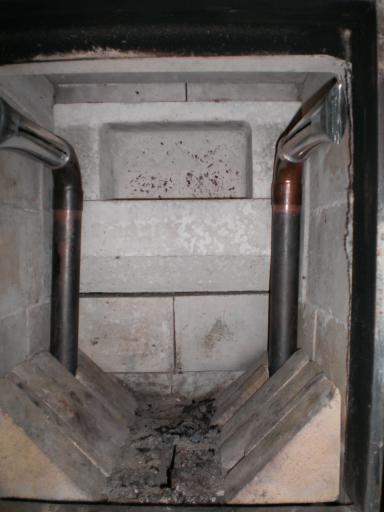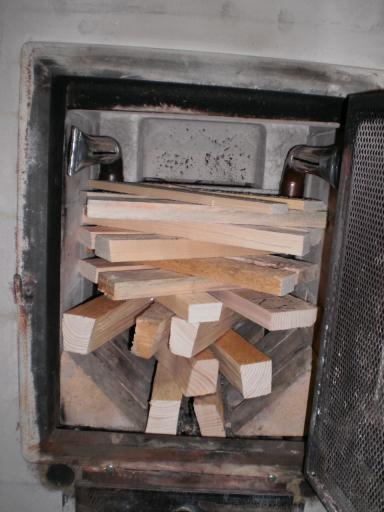Subject: Rocket/Bell
To: mheat(at)heatkit.com
From: Peter van den Berg <peter(at)pberg.demon.nl>
Date: Fri, 24 Jul 2009
Dear Mr. Senf,
About a year ago I'd started with experiments with a rocket stove -
bell system combination. The pictures and comments about the same sort
of stove on MHA has been very interesting.
The last setup, in particular, has been very close to my own first
layout. If you are interested, see http://donkey32.proboards.com . To
be able to read the content, it's necessary to register, I'm sorry. Go
to Experiments, item "rocket bell stove" plus item "project
rocket/bell".
I'm using a Testo 327 for testing, my results are very similar to
yours. However, the results could be a bit better if you are willing
to change the rocket once again. The highest efficiency reading of the
Testo 330 at your last published results is 94%, my last iteration can
reliably reach 96%. With an O2 level at its lowest of 6%, highest CO
level at the end of the burn 2500 ppm, highest flue temp 210 F.
I'll attach a small drawing in GIF format to show what I think that
would do the trick. Fuel not higher than the entrance of the syphon,
very small air supply at the bottom. Top lit/top down burn, 80% or
more of the air supply above the fuel.
The 4 inches or so above the mouth are crucial. The small heat riser
works well, a larger one doesn't have much effect. Witout the riser
the chimney warms up quite quickly, with a higher CO reading as
penalty.
The copper pipes as in my last iteration will make the burn very
reliable. But it is more work to have it function properly. Maybe a
side air supply could do the same.
Hope all this is of some use to you,
regards, Peter van den Berg
P.S. How should I recalculate my efficiency numbers in such a way that
they're comparable to yours?
Peter




Hi Peter:
Thanks very much for your comments.
Very interesting.
I may try your modifications later, when I can find some more time.
From yesterday's burn, I had the idea to lower the floor of the firebox,
and perhaps have a very coarse grate, to allow coals to drop down, and
perhaps make charcoal. It seemed like manipulating the wood was critical
in the second half of the burn. Testing on masonry heaters has led me
to the general conclusion that the fuel and fuel pile geometry have an
over-riding effect, compared to other variables.
Certainly, watching the clean part of the burn, with the combustion
air nicely downdrafting through the flaming interstices of the wood,
was a demo of how wood can be burned very cleanly. Downdrafting, in general,
seems to always have offered advantages, such as optimum mixing of hot gases.
With your permission, I'll add your comments to the project page.
To convert Testo data to a North American efficiency number, you can
download the Condar spreadsheet, which is linked.
Where it says "Gas Data from Testo Spreadsheet", just plug in your
averages for Stack Temp, O2, and CO.
You can also scroll right, and the green fields are for data entry,
for more detailed fueling calculations, etc. You will get a more
accurate number by using your actual values for moisture content,
total fuel weight, and length of run.
Best .......... Norbert Senf
Subject: Re: rocket/bell
To: mheat(at)heatkit.com
From: Peter van den Berg <peter(at)pberg.demon.nl>
Date: Fri, 24 Jul 2009
On Jul 24 Norbert Senf wrote:
> Testing on masonry heaters has led me
> to the general conclusion that the fuel and fuel pile geometry have an
> over-riding effect, compared to other variables.
Hi Norbert,
I do agree with that comment. Found the same in general terms. It's
exactly the reason why the fuel should not be piled up above the lower
lip of the syphon in my layout.
>
> Certainly, watching the clean part of the burn, with the combustion
> air nicely downdrafting through the flaming interstices of the wood,
> was a demo of how wood can be burned very cleanly. Downdrafting, in general,
> seems to always have offered advantages, such as optimum mixing of hot gases.
It took me the best part of a year's spare time to find out the
happiest burning setup. The standard rocket stove layout is not
controllable enough to my taste. Besides that, it will work reliably
with dense wood only, with soft wood the fire will creep up the feed
tube now and then.
>
> With your permission, I'll add your comments to the project page.
Please do, I'm very glad you've found my comments interesting
enough.
Thanks for the spreadsheet, I'll try that.
regards, Peter



